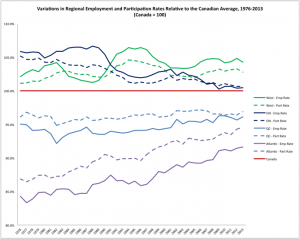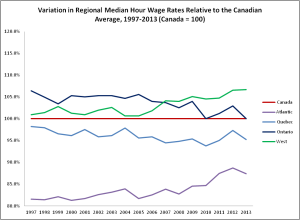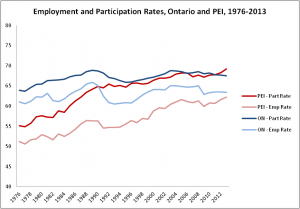
When it comes to jobs, Western Canada gets a lot of glowing attention. Much of it justified, of course. With two provincial labour markets operating at or above full employment and in the midst of an extended commodities cycle, it is undeniable that Alberta and Saskatchewan have been significant contributors to Canada’s economic performance over the last decade. Between 2000 and 2013, growth in total employment rose nearly 40% in Alberta, approximately double that of Canada as a whole. As Livio Di Matteo, economist at Lakehead University in Ontario, has remarked, Alberta’s employment ”œjuggernaut” is the economic ”œstory of the 21st century”.
Versions of this refrain, and its corollary about challenging economic realities everywhere else, get repeated often. As John Ibbitson intoned in a Globe and Mail column in early March, Alberta, and by extension the west, is now ”œthe beating heart of Canada’s economic future.”
Setting aside the obvious shift in economic activity, population and political influence toward the western provinces over the last decade, the implicit question here is whether our labour market realities are in fact diverging in ways that are of concern. In a highly regionalized economy such as Canada, it bears asking how different our labour markets really are across the country. Apart from the different structure of our regional economies, how does it differ from region to region when it comes to landing a job or the incentives to get one? Is Western Canada the ”œstory” behind the changing dynamics of jobs and income across the country?
To look at these questions, we need to take a much longer view than the performance of the last 12 months, or even the last 5 years of labour force data. Given the cyclicality of commodities (important to Western Canada) and longer-run changes in goods production (important to Central Canada)””we need to look at relative changes over many decades.
Here are several charts that begin to tell an interesting story.
In the first, I plot the changes in two key indicators of labour market performance””the labour force participation rate (the share of the population employed or looking for work), and the overall employment rate (the share of the population who are employed)””across regions, and how each of these have changed over time relative to the national average. I have defined the working-age population as ages 25 and higher to really focus in on the ages at which people are pursuing career-related work. For comparison, I have sub-divided Canada into four regions””the four Western provinces, Ontario, Quebec and the four Atlantic provinces. Some may argue with this typology.
In the second, I compare changes in median hourly wages relative the national average across these regions. Because of limitations in data, we can only look at the period since 1997.
The trend-lines are broadly the same in both charts.
Chart 1
Source: CANSIM 282-0002, calculations by author. Note: Working-age population defined as ages 25+.Chart 2
The shifting pole-position between Ontario and Western Canada is plainly obvious and of no surprise to anyone. However, two far more important observations can also be taken from this simple analysis:
- Atlantic Canada, while still considerably below the national average over the full period, has seen significant improvements on all the metrics relative to other regions of the country.
- The gap between the top and bottom performing regions appears to be shrinking, suggesting we are seeing less variance than in the past.
For all that we hear about the surging economic performance of Western Canada, and the need to find supporting labour and investment for its continued growth””the greatest relative improvement in labour force performance over the last four decades has actually been in several of the poorest provinces in Confederation, those in Atlantic Canada. Clearly, much of this shift began after the mid-1990s and is likely a response to major structural reforms in employment insurance during that time. But not all of it. The persistence of this upward trend over the long-term also suggests that this is more than a recent story about offshore oil and gas development in Newfoundland.
The significance of the regional shift in Atlantic Canada becomes particularly striking when we contrast PEI and Ontario over the same period. As shown in the following chart, the smallest province in the country, so often dependent on seasonal employment, has moved its participation rate from approximately 9 percentage points below Ontario’s in 1976, to now higher than Ontario’s by nearly 2 full percentage points. The closing of the gap between the largest and smallest provinces is equally noticeable on the employment side.
Chart 3
Source: CANSIM 282-0002, calculations by author. Note: Working-age population defined as ages 25+.The breadth of Atlantic Canada’s improvement is remarkable for many reasons. The notion that more residents in Atlantic Canada are joining the labour force and finding employment represents real hope for a region that is sometimes viewed as a source for potential labour elsewhere in Canada.
Considering that the region has historically featured an older population, and had slower population growth than the rest of the Canada, this experience may also suggest lessons for the rest of the country as we begin to deal with similar challenges nationally over the next two decades. If provinces further ahead on the curve of population ageing have been able to adjust to some of these pressures while still raising their game and closing some of the gap with the rest of the country, the rest of the country should all take notice.
Policy-makers looking to understand how to deal with future labour market challenges should look east just as much as they look west. There’s more to our labour market story than just what’s happening in Western Canada.
While the challenges facing Ontario and Quebec should concern us all, and Western Canada is indeed an ever-more important engine of growth, we can’t lose sight of what’s happening in aggregate. Over the long-term the top-line data would suggest we are seeing greater convergence on the national average across regions””and, encouragingly, faster wage growth and improving employment prospects in some poorer provinces.
That’s a good news story for the economic union, and should remind us that we are in fact more than a collection of regions with distinct cultural and economic realities.










